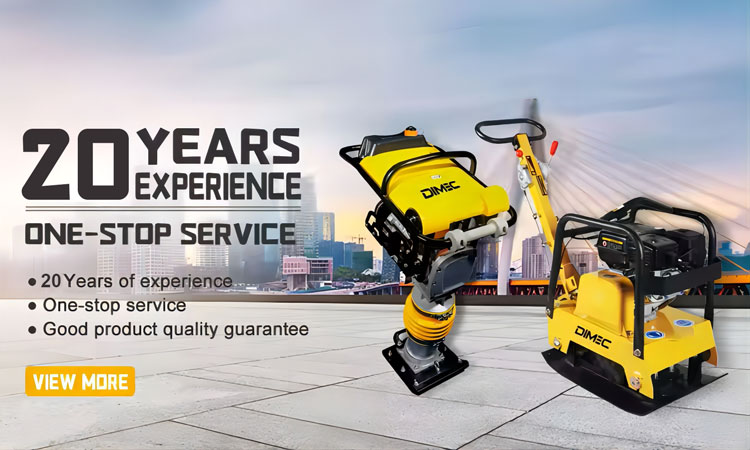Vibrator Frog Compactor Rammer – The Ultimate Guide to Soil and Asphalt Compaction
Home » Vibrator Frog Compactor Rammer – The Ultimate Guide to Soil and Asphalt Compaction

Table of Contents
What Is a Vibrator Frog Compactor Rammer?
A vibrator frog compactor rammer is a high-impact construction tool used for compacting soil, asphalt, and other granular materials. It delivers strong vibratory forces to eliminate air gaps and increase soil density, ensuring a stable and durable foundation for roads, pavements, and landscaping projects.
How Does a Vibrator Frog Compactor Rammer Work?
This machine operates using a combination of impact force and vibration. A motor-powered mechanism generates high-frequency vibrations, which are transferred to the baseplate. These vibrations, coupled with a downward thrust, help compress loose materials effectively. The ramming action ensures even compaction, reducing soil displacement over time.
Key Benefits of Using a Vibrator Frog Compactor Rammer
Enhanced Efficiency: Delivers quick and uniform compaction, saving time and labor costs.
Versatility: Suitable for various applications, including trenches, foundations, and driveways.
Improved Durability: Compacted soil withstands heavy loads and prevents structural failures.
Portability: Compact design allows for easy maneuverability in confined spaces.
Different Types of Vibrator Frog Compactor Rammers
Gasoline-Powered Rammers: Provide high mobility and powerful performance.
Electric Rammers: Ideal for indoor projects with zero emissions.
Diesel-Powered Rammers: Used for heavy-duty industrial applications requiring extended operation hours.
Essential Features to Look for in a Vibrator Frog Compactor Rammer
Engine Power: A higher horsepower ensures greater impact force.
Weight & Maneuverability: Lighter models are easier to handle, while heavier units provide deeper compaction.
Compaction Force: Measured in kilonewtons (kN), higher force ensures effective soil stabilization.
Baseplate Design: A wider baseplate covers more surface area, increasing efficiency.
Best Applications for a Vibrator Frog Compactor Rammer
Road Construction: Ensures a firm foundation for asphalt layers.
Landscaping Projects: Helps stabilize soil for patios, gardens, and walkways.
Foundation Work: Essential for compacting soil before laying concrete slabs.
Step-by-Step Guide on How to Use a Vibrator Frog Compactor Rammer
Pre-Operation Check: Inspect the engine, fuel level, and baseplate condition.
Start the Machine: Follow manufacturer instructions for ignition and throttle adjustment.
Operate with Steady Movements: Guide the rammer in a systematic pattern to ensure even compaction.
Shutdown Procedure: Turn off the machine, clean the baseplate, and store it properly.
Maintenance Tips for Longevity and Efficiency
Regular Cleaning: Remove dirt and debris after each use.
Lubrication: Keep moving parts well-oiled to reduce friction.
Routine Inspections: Check for worn-out parts and replace them promptly.
Proper Storage: Store in a dry and covered area to prevent rust and damage.
Common Problems and How to Fix Them
Engine Won’t Start: Check fuel supply, spark plugs, and air filters.
Excessive Vibrations: Inspect for loose bolts and unbalanced baseplates.
Overheating Issues: Ensure adequate ventilation and proper fuel mixture.
Safety Precautions When Operating a Vibrator Frog Compactor Rammer
Wear protective gear, including gloves, boots, and ear protection.
Maintain a firm grip on the handle to prevent accidental slips.
Avoid operating on steep slopes or unstable ground.
Keep bystanders at a safe distance to prevent injuries.
Comparing Vibrator Frog Compactor Rammers vs. Other Compacting Equipment
| Feature | Vibrator Frog Compactor Rammer | Plate Compactor | Vibratory Roller |
|---|---|---|---|
| Best Use | Trenches, confined spaces | Large flat areas | Roads, highways |
| Power Source | Gasoline, electric, diesel | Gasoline, electric | Diesel |
| Compaction Depth | Deep impact compaction | Surface-level compaction | High-speed surface compaction |
| Maneuverability | High | Moderate | Low |
Best Brands and Models on the Market Today
Wacker Neuson BS50-4As – Renowned for its powerful performance and durability.
Honda GX120 Rammer – A reliable choice with efficient fuel consumption.
Bomag BT60 – Compact design with exceptional impact force.
Buying Guide: How to Choose the Right Compactor Rammer for Your Needs
Assess the Job Requirements: Choose based on soil type and project scale.
Compare Engine Types: Gasoline for mobility, electric for eco-friendly use, and diesel for heavy-duty applications.
Check User Reviews: Look for feedback on durability and ease of use.
Consider Warranty & Support: Ensure availability of spare parts and after-sales service.
FAQs – Frequently Asked Questions
1. How often should I maintain my compactor rammer?
Regular maintenance is recommended after every 50 hours of use, with routine checks before each operation.
2. Can I use a compactor rammer on wet soil?
Yes, but avoid excessively muddy conditions as they can reduce compaction efficiency.
3. What safety gear should I wear when using a rammer?
Wear gloves, safety boots, ear protection, and a dust mask if working in dry conditions.
4. How do I store a compactor rammer properly?
Store in a dry, covered area, and drain fuel if storing for long periods.
5. Is a vibrator frog compactor rammer suitable for asphalt?
Yes, it is effective for compacting asphalt layers in road construction projects.
6. What’s the difference between a tamper and a compactor rammer?
A tamper is manual and suitable for minor jobs, whereas a compactor rammer uses mechanical force for deep soil stabilization.
Conclusion: Why a Vibrator Frog Compactor Rammer Is a Must-Have
A vibrator frog compactor rammer is an indispensable tool for construction professionals and landscapers. Its efficiency, durability, and ability to create stable foundations make it a must-have for any project requiring soil compaction. Investing in a high-quality model ensures long-term performance, safety, and cost-effectiveness.
You May Also Like